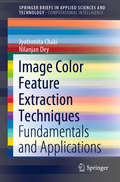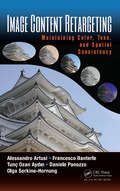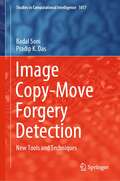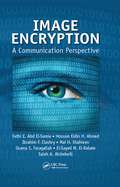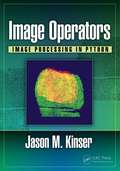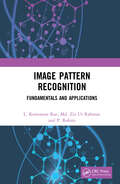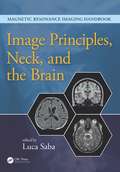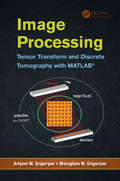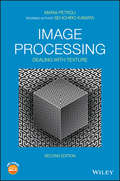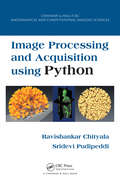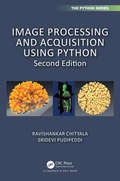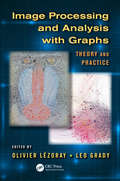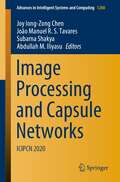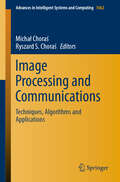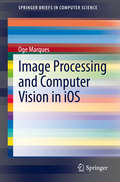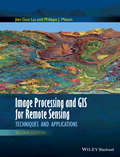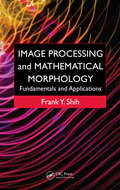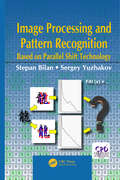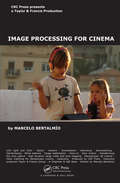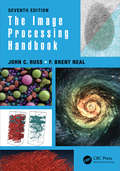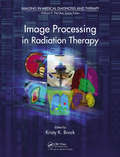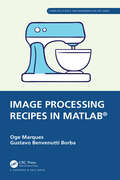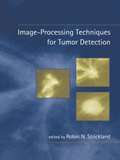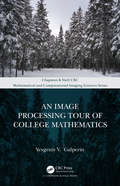- Table View
- List View
Image Color Feature Extraction Techniques: Fundamentals and Applications (SpringerBriefs in Applied Sciences and Technology)
by Jyotismita Chaki Nilanjan DeyThis book introduces a range of image color feature extraction techniques. Readers are encouraged to try implementing the techniques discussed here on their own, all of which are presented in a very simple and step-by-step manner. In addition, the book can be used as an introduction to image color feature techniques for those who are new to the research field and software. The techniques are very easy to understand as most of them are described with pictorial examples. Not only the techniques themselves, but also their applications are covered. Accordingly, the book offers a valuable guide to these tools, which are a vital component of content-based image retrieval (CBIR).
Image Content Retargeting: Maintaining Color, Tone, and Spatial Consistency
by Alessandro Artusi Francesco Banterle Tunç Ozan Aydın Daniele Panozzo Olga Sorkine-HornungIn recent years visual devices have proliferated, from the massive high-resolution, high-contrast screens to the tiny ones on mobile phones, with their limited dynamic range and color gamut. The wide variety of screens on which content may be viewed creates a challenge for developers. Adapting visual content for optimized viewing on all devices is called retargeting. This is the first book to provide a holistic view of the subject, thoroughly reviewing and analyzing the many techniques that have been developed for retargeting along dimensions such as color gamut, dynamic range, and spatial resolution.
Image Copy-Move Forgery Detection: New Tools and Techniques (Studies in Computational Intelligence #1017)
by Badal Soni Pradip K. DasThis book presents a detailed study of key points and block-based copy-move forgery detection techniques with a critical discussion about their pros and cons. It also highlights the directions for further development in image forgery detection. The book includes various publicly available standard image copy-move forgery datasets that are experimentally analyzed and presented with complete descriptions. Five different image copy-move forgery detection techniques are implemented to overcome the limitations of existing copy-move forgery detection techniques. The key focus of work is to reduce the computational time without adversely affecting the efficiency of these techniques. In addition, these techniques are also robust to geometric transformation attacks like rotation, scaling, or both.
Image Encryption: A Communication Perspective
by Osama S. Faragallah El-Sayed M. El-Rabaie Fathi E. Abd El-Samie Hossam Eldin Ahmed Ibrahim F. Elashry Mai H. Shahieen Saleh A. AlshebeiliInvestigating image encryption approaches, this book examines image encryption algorithms for the purpose of wireless communication of images in secure form. It considers two directions for image encryption: permutation-based encryption and diffusion-based encryption. Covering the range of image encryption principles and techniques, it presents hybrid encryption algorithms to enhance the characteristics of traditional algorithms. It explores number theory-based encryption algorithms, details the strength of different encryption algorithms, and describes their ability to work within the limitations of wireless communication systems.
Image Operators: Image Processing in Python
by Jason M. KinserFor decades, researchers have been developing algorithms to manipulate and analyze images. From this, a common set of image tools now appear in many high-level programming languages. Consequently, the amount of coding required by a user has significantly lessened over the years. While the libraries for image analysis are coalescing to a common toolkit, the language of image analysis has remained stagnant. Often, textual descriptions of an analytical protocol consume far more real estate than does the computer code required to execute the processes. Furthermore, the textual explanations are sometimes vague or incomplete. This book offers a precise mathematical language for the field of image processing. Defined operators correspond directly to standard library routines, greatly facilitating the translation between mathematical descriptions and computer script. This text is presented with Python 3 examples. This text will provide a unified language for image processing Provides the theoretical foundations with accompanied Python® scripts to precisely describe steps in image processing applications Linkage between scripts and theory through operators will be presented All chapters will contain theories, operator equivalents, examples, Python® codes, and exercises
Image Pattern Recognition: Fundamentals and Applications
by L Koteswara Rao Md. Zia Rahman P RohiniThis book describes various types of image patterns for image retrieval. All these patterns are texture dependent. Few image patterns such as Improved directional local extrema patterns, Local Quantized Extrema Patterns, Local Color Oppugnant Quantized Extrema Patterns and Local Mesh quantized extrema patterns are presented. Inter-relationships among the pixels of an image are used for feature extraction. In contrast to the existing patterns these patterns focus on local neighborhood of pixels to creates the feature vector. Evaluation metrics such as precision and recall are calculated after testing with standard databases i.e., Corel-1k, Corel-5k and MIT VisTex database. This book serves as a practical guide for students and researchers. -The text introduces two models of Directional local extrema patterns viz., Integration of color and directional local extrema patterns Integration of Gabor features and directional local extrema patterns. -Provides a framework to extract the features using quantization method -Discusses the local quantized extrema collected from two oppugnant color planes -Illustrates the mesh structure with the pixels at alternate positions.
Image Principles, Neck, and the Brain
by Luca SabaMagnetic resonance imaging (MRI) is a technique used in biomedical imaging and radiology to visualize internal structures of the body. Because MRI provides excellent contrast between different soft tissues, the technique is especially useful for diagnostic imaging of the brain, muscles, and heart.In the past 20 years, MRI technology has improved si
Image Processing: Tensor Transform and Discrete Tomography with MATLAB ®
by Artyom M. Grigoryan Merughan M. GrigoryanFocusing on mathematical methods in computer tomography, Image Processing: Tensor Transform and Discrete Tomography with MATLAB® introduces novel approaches to help in solving the problem of image reconstruction on the Cartesian lattice. Specifically, it discusses methods of image processing along parallel rays to more quickly and accurately reconstruct images from a finite number of projections, thereby avoiding overradiation of the body during a computed tomography (CT) scan. The book presents several new ideas, concepts, and methods, many of which have not been published elsewhere. New concepts include methods of transferring the geometry of rays from the plane to the Cartesian lattice, the point map of projections, the particle and its field function, and the statistical model of averaging. The authors supply numerous examples, MATLAB®-based programs, end-of-chapter problems, and experimental results of implementation. The main approach for image reconstruction proposed by the authors differs from existing methods of back-projection, iterative reconstruction, and Fourier and Radon filtering. In this book, the authors explain how to process each projection by a system of linear equations, or linear convolutions, to calculate the corresponding part of the 2-D tensor or paired transform of the discrete image. They then describe how to calculate the inverse transform to obtain the reconstruction. The proposed models for image reconstruction from projections are simple and result in more accurate reconstructions. Introducing a new theory and methods of image reconstruction, this book provides a solid grounding for those interested in further research and in obtaining new results. It encourages readers to develop effective applications of these methods in CT.
Image Processing: Dealing with Texture
by Maria M. Petrou Sei-ichiro KamataThe classic text that covers practical image processing methods and theory for image texture analysis, updated second edition The revised second edition of Image Processing: Dealing with Textures updates the classic work on texture analysis theory and methods without abandoning the foundational essentials of this landmark work. Like the first, the new edition offers an analysis of texture in digital images that are essential to a diverse range of applications such as: robotics, defense, medicine and the geo-sciences. Designed to easily locate information on specific problems, the text is structured around a series of helpful questions and answers. Updated to include the most recent developments in the field, many chapters have been completely revised including: Fractals and Multifractals, Image Statistics, Texture Repair, Local Phase Features, Dual Tree Complex Wavelet Transform, Ridgelets and Curvelets and Deep Texture Features. The book takes a two-level mathematical approach: light math is covered in the main level of the book, with harder math identified in separate boxes. This important text: Contains an update of the classic advanced text that reviews practical image processing methods and theory for image texture analysis Puts the focus exclusively on an in-depth exploration of texture Contains a companion website with exercises and algorithms Includes examples that are fully worked to enhance the learning experience Written for students and researchers of image processing, the second edition of Image Processing has been revised and updated to incorporate the foundational information on the topic and information on the latest advances.
Image Processing and Acquisition using Python (Chapman And Hall/crc Mathematical And Computational Imaging Sciences Ser.)
by Ravishankar Chityala Sridevi PudipeddiImage Processing and Acquisition using Python provides readers with a sound foundation in both image acquisition and image processing-one of the first books to integrate these topics together. By improving readers' knowledge of image acquisition techniques and corresponding image processing, the book will help them perform experiments more effectiv
Image Processing and Acquisition using Python (Chapman & Hall/CRC The Python Series)
by Ravishankar Chityala Sridevi PudipeddiImage Processing and Acquisition using Python provides readers with a sound foundation in both image acquisition and image processing—one of the first books to integrate these topics together. By improving readers’ knowledge of image acquisition techniques and corresponding image processing, the book will help them perform experiments more effectively and cost efficiently as well as analyze and measure more accurately. Long recognized as one of the easiest languages for non-programmers to learn, Python is used in a variety of practical examples. A refresher for more experienced readers, the first part of the book presents an introduction to Python, Python modules, reading and writing images using Python, and an introduction to images. The second part discusses the basics of image processing, including pre/post processing using filters, segmentation, morphological operations, and measurements. The second part describes image acquisition using various modalities, such as x-ray, CT, MRI, light microscopy, and electron microscopy. These modalities encompass most of the common image acquisition methods currently used by researchers in academia and industry. Features Covers both the physical methods of obtaining images and the analytical processing methods required to understand the science behind the images. Contains many examples, detailed derivations, and working Python examples of the techniques. Offers practical tips on image acquisition and processing. Includes numerous exercises to test the reader’s skills in Python programming and image processing, with solutions to selected problems, example programs, and images available on the book’s web page. New to this edition Machine learning has become an indispensable part of image processing and computer vision, so in this new edition two new chapters are included: one on neural networks and the other on convolutional neural networks. A new chapter on affine transform and many new algorithms. Updated Python code aligned to the latest version of modules.
Image Processing and Analysis with Graphs: Theory and Practice (Digital Imaging and Computer Vision #5)
by OLIVER LÉZORAY AND LEO GRADYCovering the theoretical aspects of image processing and analysis through the use of graphs in the representation and analysis of objects, Image Processing and Analysis with Graphs: Theory and Practice also demonstrates how these concepts are indispensible for the design of cutting-edge solutions for real-world applications. Explores new applications in computational photography, image and video processing, computer graphics, recognition, medical and biomedical imaging With the explosive growth in image production, in everything from digital photographs to medical scans, there has been a drastic increase in the number of applications based on digital images. This book explores how graphs—which are suitable to represent any discrete data by modeling neighborhood relationships—have emerged as the perfect unified tool to represent, process, and analyze images. It also explains why graphs are ideal for defining graph-theoretical algorithms that enable the processing of functions, making it possible to draw on the rich literature of combinatorial optimization to produce highly efficient solutions. Some key subjects covered in the book include: Definition of graph-theoretical algorithms that enable denoising and image enhancement Energy minimization and modeling of pixel-labeling problems with graph cuts and Markov Random Fields Image processing with graphs: targeted segmentation, partial differential equations, mathematical morphology, and wavelets Analysis of the similarity between objects with graph matching Adaptation and use of graph-theoretical algorithms for specific imaging applications in computational photography, computer vision, and medical and biomedical imaging Use of graphs has become very influential in computer science and has led to many applications in denoising, enhancement, restoration, and object extraction. Accounting for the wide variety of problems being solved with graphs in image processing and computer vision, this book is a contributed volume of chapters written by renowned experts who address specific techniques or applications. This state-of-the-art overview provides application examples that illustrate practical application of theoretical algorithms. Useful as a support for graduate courses in image processing and computer vision, it is also perfect as a reference for practicing engineers working on development and implementation of image processing and analysis algorithms.
Image Processing and Capsule Networks: ICIPCN 2020 (Advances in Intelligent Systems and Computing #1200)
by João Manuel R. S. Tavares Joy Iong-Zong Chen Subarna Shakya Abdullah M. IliyasuThis book emphasizes the emerging building block of image processing domain, which is known as capsule networks for performing deep image recognition and processing for next-generation imaging science. Recent years have witnessed the continuous development of technologies and methodologies related to image processing, analysis and 3D modeling which have been implemented in the field of computer and image vision. The significant development of these technologies has led to an efficient solution called capsule networks [CapsNet] to solve the intricate challenges in recognizing complex image poses, visual tasks, and object deformation. Moreover, the breakneck growth of computation complexities and computing efficiency has initiated the significant developments of the effective and sophisticated capsule network algorithms and artificial intelligence [AI] tools into existence. The main contribution of this book is to explain and summarize the significant state-of-the-art research advances in the areas of capsule network [CapsNet] algorithms and architectures with real-time implications in the areas of image detection, remote sensing, biomedical image analysis, computer communications, machine vision, Internet of things, and data analytics techniques.
Image Processing and Communications: Techniques, Algorithms and Applications (Advances in Intelligent Systems and Computing #1062)
by Michał Choraś Ryszard S. ChoraśThis book presents a selection of high-quality peer-reviewed research papers on various aspects of computer science and networks. It not only discusses emerging applications of currently available solutions, but also outlines potential future techniques and lines of research in pattern recognition, image processing and communications. Given its scope, the book will be of considerable interest to researchers, students and practitioners alike. All papers gathered here were presented at the Image Processing and Communications Conference, held in Bydgoszcz, Poland on September 11–13, 2019.
Image Processing and Computer Vision in iOS (SpringerBriefs in Computer Science)
by Oge MarquesThis book presents the fundamentals of mobile visual computing in iOS development and provides directions for developers and researchers interested in developing iOS applications with image processing and computer vision capabilities. Presenting a technical overview of some of the tools, languages, libraries, frameworks, and APIs currently available for developing iOS applications Image Processing and Computer Vision in iOS reveals the rich capabilities in image processing and computer vision. Its main goal is to provide a road map to what is currently available, and a path to successfully tackle this rather complex but highly rewarding task.
Image Processing and Data Analysis with ERDAS IMAGINE®
by Stacy A.C. Nelson Siamak KhorramRemotely sensed data, in the form of digital images captured from spaceborne and airborne platforms, provide a rich analytical and observational source of information about the current status, as well as changes occurring in, on, and around the Earth’s surface. The data products, or simply images processed from these platforms, provide an additional advantage in that geographic areas or regions of interest can be revisited on a regular cycle. This revisit cycle allows geospatial analysts and natural resource managers to explore changing conditions over time. Image Processing and Data Analysis with ERDAS IMAGINE® explains the principles behind the processing of remotely sensed data in a simple, easy to understand, and "how-to" format. Organized as a step-by-step guide with exercises adapted from original research and using publicly available imagery, such as NASA Landsat, ESA Sentinel-2, Orthophotos, and others, this book gives readers the ability to quickly gain the practical experience needed to navigate the ERDAS IMAGINE® software as well as learn certain applications in Esri’s ArcMap ArcGIS for Desktop software and Quantum the GIS (QGIS) open source applications package. It also helps readers to easily move beyond the information presented in this book and tackle more advanced skills. Written by two professors with long experience in remote sensing and image processing, this book is a useful guide and reference for both undergraduate and graduate students, researchers, instructors, managers, and agency professionals who are involved in the study of Earth systems and the environment.
Image Processing and GIS for Remote Sensing: Techniques and Applications
by Jian Guo Liu Philippa J. MasonFollowing the successful publication of the 1st edition in 2009, the 2nd edition maintains its aim to provide an application-driven package of essential techniques in image processing and GIS, together with case studies for demonstration and guidance in remote sensing applications. The book therefore has a “3 in 1” structure which pinpoints the intersection between these three individual disciplines and successfully draws them together in a balanced and comprehensive manner. The book conveys in-depth knowledge of image processing and GIS techniques in an accessible and comprehensive manner, with clear explanations and conceptual illustrations used throughout to enhance student learning. The understanding of key concepts is always emphasised with minimal assumption of prior mathematical experience. The book is heavily based on the authors’ own research. Many of the author-designed image processing techniques are popular around the world. For instance, the SFIM technique has long been adopted by ASTRIUM for mass-production of their standard “Pan-sharpen” imagery data. The new edition also includes a completely new chapter on subpixel technology and new case studies, based on their recent research.
Image Processing and Mathematical Morphology: Fundamentals and Applications
by Frank Y. ShihIn the development of digital multimedia, the importance and impact of image processing and mathematical morphology are well documented in areas ranging from automated vision detection and inspection to object recognition, image analysis and pattern recognition. Those working in these ever-evolving fields require a solid grasp of basic fundamentals, theory, and related applications—and few books can provide the unique tools for learning contained in this text. Image Processing and Mathematical Morphology: Fundamentals and Applications is a comprehensive, wide-ranging overview of morphological mechanisms and techniques and their relation to image processing. More than merely a tutorial on vital technical information, the book places this knowledge into a theoretical framework. This helps readers analyze key principles and architectures and then use the author’s novel ideas on implementation of advanced algorithms to formulate a practical and detailed plan to develop and foster their own ideas. The book: Presents the history and state-of-the-art techniques related to image morphological processing, with numerous practical examples Gives readers a clear tutorial on complex technology and other tools that rely on their intuition for a clear understanding of the subject Includes an updated bibliography and useful graphs and illustrations Examines several new algorithms in great detail so that readers can adapt them to derive their own solution approaches This invaluable reference helps readers assess and simplify problems and their essential requirements and complexities, giving them all the necessary data and methodology to master current theoretical developments and applications, as well as create new ones.
Image Processing and Pattern Recognition Based on Parallel Shift Technology
by Stepan Bilan Sergey YuzhakovThis book describes the methods and algorithms for image pre-processing and recognition. These methods are based on a parallel shift technology of the imaging copy, as well as simple mathematical operations to allow the generation of a minimum set of features to describe and recognize the image. This book also describes the theoretical foundations of parallel shift technology and pattern recognition. Based on these methods and theories, this book is intended to help researchers with artificial intelligence systems design, robotics, and developing software and hardware applications.
Image Processing for Cinema (Chapman & Hall/CRC Mathematical and Computational Imaging Sciences Series)
by Marcelo BertalmioImage Processing for Cinema presents a detailed overview of image processing techniques that are used in practice in digital cinema. The book shows how image processing has become ubiquitous in movie-making, from shooting to exhibition. It covers all the ways in which image processing algorithms are used to enhance, restore, adapt, and convert movi
The Image Processing Handbook
by John C. Russ F. Brent NealConsistently rated as the best overall introduction to computer-based image processing, The Image Processing Handbook covers two-dimensional (2D) and three-dimensional (3D) imaging techniques, image printing and storage methods, image processing algorithms, image and feature measurement, quantitative image measurement analysis, and more.Incorporating image processing and analysis examples at all scales, from nano- to astro-, this Seventh Edition: Features a greater range of computationally intensive algorithms than previous versions Provides better organization, more quantitative results, and new material on recent developments Includes completely rewritten chapters on 3D imaging and a thoroughly revamped chapter on statistical analysis Contains more than 1700 references to theory, methods, and applications in a wide variety of disciplines Presents 500+ entirely new figures and images, with more than two-thirds appearing in color The Image Processing Handbook, Seventh Edition delivers an accessible and up-to-date treatment of image processing, offering broad coverage and comparison of algorithms, approaches, and outcomes.
Image Processing in Radiation Therapy (Imaging in Medical Diagnosis and Therapy)
by Kristy K. BrockImages from CT, MRI, PET, and other medical instrumentation have become central to the radiotherapy process in the past two decades, thus requiring medical physicists, clinicians, dosimetrists, radiation therapists, and trainees to integrate and segment these images efficiently and accurately in a clinical environment. Image Processing in Radiation
Image Processing Recipes in MATLAB® (Chapman & Hall/CRC Computer Science and Engineering Recipes Series)
by Oge Marques Gustavo Benvenutti BorbaLeveraging the latest developments in MATLAB and its image processing toolbox, this 'cookbook' is a collection of 30 practical recipes for image processing, ranging from foundational techniques to recently published algorithms. Presented in a clear and meaningful sequence, these recipes are prepared with the reader in mind, allowing one to focus on particular topics or read as a whole from cover to cover.Key Features: A practical, user-friendly guide that equips researchers and practitioners with the tools to implement efficient image processing workflows in MATLAB. Each recipe is presented through clear, step-by-step instructions and rich visual examples. Each recipe contains its own source code, explanations, and figures, making the book an excellent standalone resource for quick reference. Strategically structured to aid sequential learning, yet with self-contained chapters for those seeking solutions to specific image processing challenges. The book serves as a concise and readable practical reference to deploy image processing pipelines in MATLAB quickly and efficiently. With its accessible and practical approach, the book is a valuable guide for those who navigate this evolving area, including researchers, students, developers, and practitioners in the fields of image processing, computer vision, and image analysis.
Image-Processing Techniques for Tumor Detection
by David F. Ross"Provides a current review of computer processing algorithms for the identification of lesions, abnormal masses, cancer, and disease in medical images. Presents useful examples from numerous imaging modalities for increased recognition of anomolies in MRI, CT, SPECT and digital/film X-Ray."
An Image Processing Tour of College Mathematics (Chapman & Hall/CRC Mathematical and Computational Imaging Sciences Series)
by Yevgeniy V. GalperinAn Image Processing Tour of College Mathematics aims to provide meaningful context for reviewing key topics of the college mathematics curriculum, to help students gain confidence in using concepts and techniques of applied mathematics, to increase student awareness of recent developments in mathematical sciences, and to help students prepare for graduate studies. The topics covered include a library of elementary functions, basic concepts of descriptive statistics, probability distributions of functions of random variables, definitions and concepts behind first- and second-order derivatives, most concepts and techniques of traditional linear algebra courses, an introduction to Fourier analysis, and a variety of discrete wavelet transforms – all of that in the context of digital image processing. Features Pre-calculus material and basic concepts of descriptive statistics are reviewed in the context of image processing in the spatial domain. Key concepts of linear algebra are reviewed both in the context of fundamental operations with digital images and in the more advanced context of discrete wavelet transforms. Some of the key concepts of probability theory are reviewed in the context of image equalization and histogram matching. The convolution operation is introduced painlessly and naturally in the context of naïve filtering for denoising and is subsequently used for edge detection and image restoration. An accessible elementary introduction to Fourier analysis is provided in the context of image restoration. Discrete wavelet transforms are introduced in the context of image compression, and the readers become more aware of some of the recent developments in applied mathematics. This text helps students of mathematics ease their way into mastering the basics of scientific computer programming.
